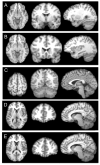Developmental meta-analyses of the functional neural correlates of bipolar disorder
- PMID: 25100166
- PMCID: PMC4545589
- DOI: 10.1001/jamapsychiatry.2014.660
Developmental meta-analyses of the functional neural correlates of bipolar disorder
Abstract
Importance: Bipolar disorder (BD) is a debilitating mental illness associated with high costs to diagnosed individuals and society. Within the past 2 decades, increasing numbers of children and adolescents have been diagnosed as having BD. While functional magnetic resonance imaging (fMRI) studies have begun to investigate the neural mechanisms underlying BD, few have directly compared differences in youths with BD and adults with BD (hereafter BD-youths and BD-adults, respectively).
Objective: To test the hypothesis that BD-youths (<18 years old) would show greater convergence of amygdala hyperactivation and prefrontal cortical hypoactivation vs BD-adults.
Data sources: PubMed and PsycINFO databases were searched on July 17, 2013, for original, task-related coordinate-based fMRI articles.
Study selection: In total, 21 pediatric studies, 73 adult studies, and 2 studies containing distinct pediatric and adult groups within the same study met inclusion criteria for our ALE analyses.
Data extraction and synthesis: Coordinates of significant between-group differences were extracted from each published study. Recent improvements in GingerALE software were used to perform direct comparisons of pediatric and adult fMRI findings. We conducted activation likelihood estimation (ALE) meta-analyses directly comparing the voxelwise convergence of fMRI findings in BD-youths vs BD-adults, both relative to healthy control (HC) participants.
Results: Analyses of emotional face recognition fMRI studies showed significantly greater convergence of amygdala hyperactivation among BD-youths than BD-adults. More broadly, analyses of fMRI studies using emotional stimuli showed significantly greater convergence of hyperactivation among BD-youths than BD-adults in the inferior frontal gyrus and precuneus. In contrast, analyses of fMRI studies using nonemotional cognitive tasks and analyses aggregating emotional and nonemotional tasks showed significantly greater convergence of hypoactivation among BD-youths than BD-adults in the anterior cingulate cortex.
Conclusions and relevance: Our data suggest that amygdala, prefrontal, and visual system hyperactivation is important in the emotional dysfunction present in BD-youths, as well as that anterior cingulate cortex hypoactivation is relevant to the cognitive deficits in BD-youths. Future studies are required to determine if the developmental fMRI differences between BD-youths and BD-adults identified by our ALE meta-analyses are useful as brain-based diagnostic or treatment markers of BD, including either longitudinal neuroimaging studies of BD-youths as they become adults or cross-sectional imaging studies directly comparing BD-youths with BD-adults.
Conflict of interest statement
All authors report no conflicts of interest.
Figures


Similar articles
-
Association Between the Fronto-Limbic Network and Cognitive and Emotional Functioning in Individuals With Bipolar Disorder: A Systematic Review and Meta-analysis.JAMA Psychiatry. 2023 May 1;80(5):432-440. doi: 10.1001/jamapsychiatry.2023.0131. JAMA Psychiatry. 2023. PMID: 36988918 Free PMC article.
-
Developmental meta-analysis of the functional neural correlates of autism spectrum disorders.J Am Acad Child Adolesc Psychiatry. 2013 Mar;52(3):279-289.e16. doi: 10.1016/j.jaac.2012.12.012. J Am Acad Child Adolesc Psychiatry. 2013. PMID: 23452684 Free PMC article.
-
Limbic and cortical regions as functional biomarkers associated with emotion regulation in bipolar disorder: A meta-analysis of neuroimaging studies.J Affect Disord. 2023 Feb 15;323:506-513. doi: 10.1016/j.jad.2022.11.071. Epub 2022 Nov 30. J Affect Disord. 2023. PMID: 36462610 Review.
-
A developmental study of the neural circuitry mediating motor inhibition in bipolar disorder.Am J Psychiatry. 2012 Jun;169(6):633-41. doi: 10.1176/appi.ajp.2012.11081244. Am J Psychiatry. 2012. PMID: 22581312 Free PMC article.
-
Prefrontal, parietal, and limbic condition-dependent differences in bipolar disorder: a large-scale meta-analysis of functional neuroimaging studies.Mol Psychiatry. 2023 Jul;28(7):2826-2838. doi: 10.1038/s41380-023-01974-8. Epub 2023 Feb 13. Mol Psychiatry. 2023. PMID: 36782061 Free PMC article.
Cited by
-
Facial emotion recognition in childhood-onset bipolar I disorder: an evaluation of developmental differences between youths and adults.Bipolar Disord. 2015 Aug;17(5):471-85. doi: 10.1111/bdi.12312. Epub 2015 May 8. Bipolar Disord. 2015. PMID: 25951752 Free PMC article.
-
Intrinsic Amygdala Functional Connectivity in Youth With Bipolar I Disorder.J Am Acad Child Adolesc Psychiatry. 2015 Sep;54(9):763-70. doi: 10.1016/j.jaac.2015.06.016. Epub 2015 Jul 6. J Am Acad Child Adolesc Psychiatry. 2015. PMID: 26299298 Free PMC article.
-
Cognitive control under stressful conditions in transitional age youth with bipolar disorder: Diagnostic and sleep-related differences in fronto-limbic activation patterns.Bipolar Disord. 2018 May;20(3):238-247. doi: 10.1111/bdi.12583. Epub 2018 Feb 13. Bipolar Disord. 2018. PMID: 29441653 Free PMC article.
-
Transdiagnostic impairment of cognitive control in mental illness.J Psychiatr Res. 2016 Dec;83:37-46. doi: 10.1016/j.jpsychires.2016.08.001. Epub 2016 Aug 5. J Psychiatr Res. 2016. PMID: 27552532 Free PMC article. Review.
-
Early intervention for youth at high risk for bipolar disorder: A multisite randomized trial of family-focused treatment.Early Interv Psychiatry. 2019 Apr;13(2):208-216. doi: 10.1111/eip.12463. Epub 2017 Aug 4. Early Interv Psychiatry. 2019. PMID: 28776930 Free PMC article. Clinical Trial.
References
-
- Kleinman L, Lowin A, Flood E, Gandhi G, Edgell E, Revicki D. Costs of bipolar disorder. Pharmacoeconomics. 2003;21(9):601–622. - PubMed
-
- Keck PE, Jr, Kessler RC, Ross R. Clinical and economic effects of unrecognized or inadequately treated bipolar disorder. J Psychiatr Pract. 2008;14(2):31–38. - PubMed
-
- Leboyer M, Henry C, Paillere-Martinot ML, Bellivier F. Age at onset in bipolar affective disorders: a review. Bipolar Disord. 2005;7(2):111–118. - PubMed
Publication types
MeSH terms
Grants and funding
- T32 MH019927/MH/NIMH NIH HHS/United States
- R01 MH087513/MH/NIMH NIH HHS/United States
- 1R21-MH096850/MH/NIMH NIH HHS/United States
- R01-MH084812/MH/NIMH NIH HHS/United States
- 5R01-MH092450/MH/NIMH NIH HHS/United States
- 5R01-MH087513/MH/NIMH NIH HHS/United States
- 1R01-MH099703/MH/NIMH NIH HHS/United States
- R01 MH084812/MH/NIMH NIH HHS/United States
- R01 MH092450/MH/NIMH NIH HHS/United States
- R21 MH096850/MH/NIMH NIH HHS/United States
- R01 MH074457/MH/NIMH NIH HHS/United States
- R01-MH074457/MH/NIMH NIH HHS/United States
- 5T32-MH019927-20/MH/NIMH NIH HHS/United States
LinkOut - more resources
Full Text Sources
Other Literature Sources
Medical
Miscellaneous

